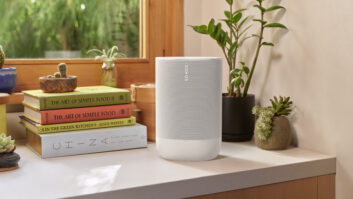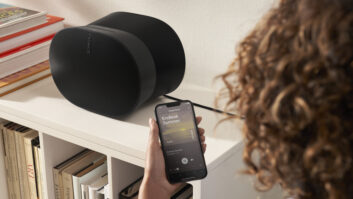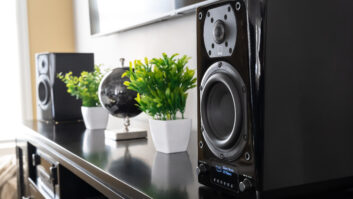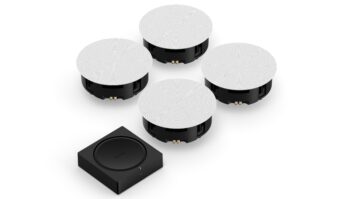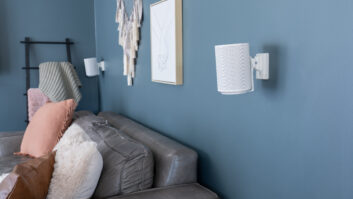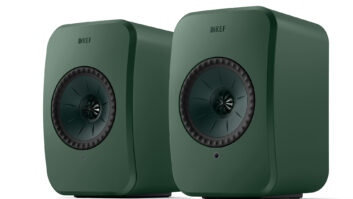UPDATE FROM SONOS — July 10, 2020
• New Lunar White Model. Move is now available in Lunar White. Like its Shadow Black counterpart, the Lunar White Move is weatherproof, drop-resistant, and with its IP56 rating, can handle sandy beaches, summer sweat, a quick rinse with the hose and more. Both colors are UV-resistant, so you can keep your favorite tracks and stations playing all day without overheating.
• Now with 11 Hours of battery life. Through a recent software update, Sonos increased Move’s battery life from 10 to 11 hours of continuous play time.
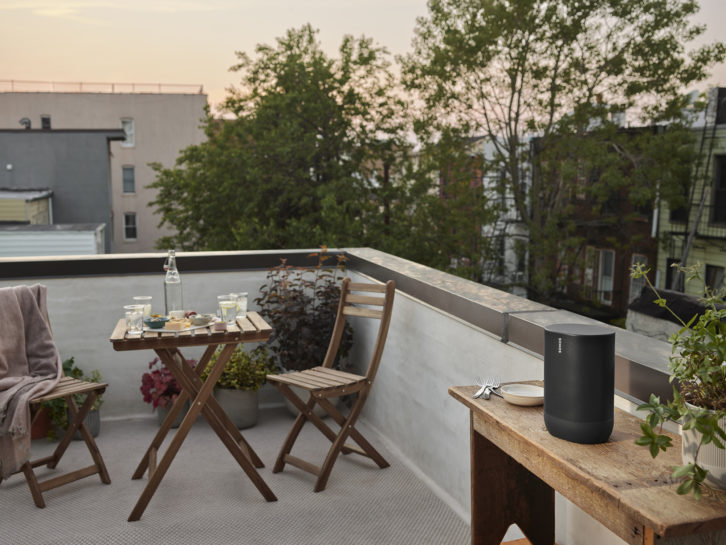
At this point, I think I’ve tested and reviewed almost every widely available wireless audio distribution technology out there, including Lenbrook’s Bluesound, D&M’s HEOS, Nuvo, Russound’s MBX, and Yamaha’s MusicCast, as well as multiple products that support DTS’ Play-Fi, Google’s ChromeCast, Bluetooth, and AirPlay. But as good as some of these systems are, in the end they all draw one, single, inevitable question: How do they compare to Sonos?
When you talk about wireless audio systems, Sonos is the elephant in the room. They advertised during the Super Bowl for Pete’s sake! Sonos is also likely one of the few products (along with Sony, Samsung, and Bose) that your customers actually know and ask for by name. And selling Sonos is often just a case of mentioning Sonos, as most people have had some familiarity with the brand by this point, either in their own home, or that of a friend or family member.
I’ve heard it said that early on Sonos claimed it was not an audio company, but rather a software company that made audio products. And whether that’s true or just become an audio industry urban legend, it’s really one of the things that has separated Sonos from the pack and made the company’s name almost synonymous with “wireless audio” in many people’s minds. The truth is, modern computer design has made the manufacturing of a good-sounding speaker a lot easier than building a robust software platform to drive it. And by having a “software-first” mentality, Sonos steadily built an ecosystem and app that just works.
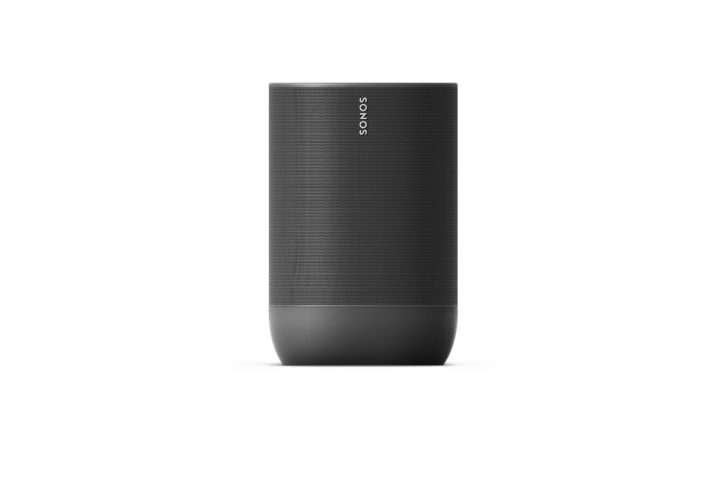
And while I know that there are pockets of this industry that have branded Sonos with the mark of Cain for whatever reason — “You can buy it everywhere!” “There’s no margin!” “They don’t care about this channel!” “They won’t give us deep integration with our preferred control system!” — I’m just gonna say up front that this review is not for you. I’m not going to presume to think that my review will change the way you feel about Sonos, so feel free to save your comments and move on.
But for those of you that have embraced Sonos, or are thinking about starting to carry the line (especially as it is now available from SnapAV), and have been looking for a product that virtually every one of your customers has been asking for, then read on!
I remember speaking with my Sonos regional rep once and suggesting a product I thought would be perfect for our channel. (For the record, it was an audiophile version of the Connect.) While he conceded that it might be a good product, he said it was a little too niche. “We don’t want to make a product that will sell thousands. We’re only interested in making something that will sell millions.”
In that vein, I give you the Sonos Move: the company’s first truly wireless and portable speaker that will become a staple of your Sonos installations.
At some point during the Sonos sales process, usually when you are asking them all of the rooms where they would like to add music so you can determine the required number of speakers, the customer inevitably asks about the ability to move a speaker around the house. “I don’t need a speaker in my [insert room name here] all the time; could I just carry one of these speakers into another room if I wanted? Or could I take it outside? Will these speakers work anywhere?”
The Move is designed to address all of these issues/questions and more.
Since the Play:5, Sonos has upped its packaging game, and as many Sonos products are likely to be opened by the end user, a quality unboxing experience makes a nice first impression. The box has four-color art on its sides, and opens to reveal a Welcome Guide followed by the speaker shrouded in a soft, black baggie that can serve as a travel tote. There is also a small box that contains the charging base and power supply.
Once out of the baggie, you’ll see the speaker is larger than a Sonos One in every dimension (though just fractionally deeper), yet its rounded design and curved sides doesn’t make it feel large. At 6.61 pounds, the speaker has some nice heft, which speaks to solid build quality, but the terrifically integrated cavity on the back of the speaker that doubles as a carry handle makes it simple and intuitive to grab and carry around.
Getting things to lock into charging docks or cradles can often be a challenge as you try to line up the connectors or pins, or manually connect a plug to charge, and the simplicity of the Move’s charging base is a thing of genius. The charging base is an open ring that you just set the speaker into and lift it out of. No hassle, no struggle, no “I didn’t put it in correctly and now my speaker is dead.” Customers wanting to move the speaker around on a regular basis can purchase additional charging bases, or use a USB-C charger on the speaker’s rear panel. It’s important to note the charging base is not weatherproof and only meant for indoor use.
Where other wireless companies (HEOS, Riva, Bluesound) have just added an optional battery pack to existing speakers to make them portable, Sonos designed the Move from the ground up for portability and it shows in its thoughtful design. The Move’s battery is not some snap-on accessory, but rather is integrated into the base of the speaker. This not only gives it nice balance and weight for the speaker to sit sturdily on a counter, but it is one less connection point to fail. It is also slightly rubberized so it won’t damage anything you set it on.
Sonos says the 36-watt-hour battery will last “up to 10 hours of uninterrupted playback,” but things like volume level, heat exposure, and other factors can affect this performance. In my experience, the battery lived up to its rating, certainly providing enough juice for a day’s entertainment off the base. Also, the battery has a really slow discharge rate — mine arrived with still more than 50 percent battery power remaining — meaning you can easily take it for a long weekend getaway. Going from 0 percent battery to a 100 percent charge takes about an hour and 45 minutes, and the battery is rated to last “about three years or 900 charges,” after which customers will be able to replace the battery. When asked about the replacement process, I was told, “We’re going to be sharing more info about battery replacement process at a later date.”
The speaker’s flat top features capacitive touch controls for adjusting volume, skipping tracks, play/pause, and toggling the four far-field microphone array on/off. A separate LED indicates when the microphone is active so those concerned with privacy can know when it is listening. I found the microphones to be quite adept at hearing my voice, even from a distance and talking over loud music.
Beyond Google Assistant and Amazon Alexa support, Move uses its microphone array for Sonos’ Trueplay to tune the audio for optimal sound in any listening environment. Whereas using Trueplay on previous Sonos products meant waving your iPhone around for a few minutes and remeasuring if the speaker moved, Move’s new Auto Trueplay setting allows it to constantly take measurements and make adjustments whenever its microphones are enabled, ensuring sound is always perfect. This is another fantastic integration.
For worry-free playback on-the-go, Move has an IP56 rating, meaning it can withstand “very fine particles, such as dust, and heavy liquid splashing, including heavy rain and snowfall.” So, feel free to listen by the pool, take it to the beach, bring it to the park, or whatever. Also, the ruggedized case is designed to shrug off falls up to six feet, so there’s no need to baby the Move.
For truly portable, off-your-network listening, Move is also the first Sonos product to incorporate Bluetooth. A single button on the back toggles the speaker in and out of Bluetooth mode, with the top LED illuminating blue to indicate Bluetooth operation. There is no mini-jack or other means of connecting a separate device.
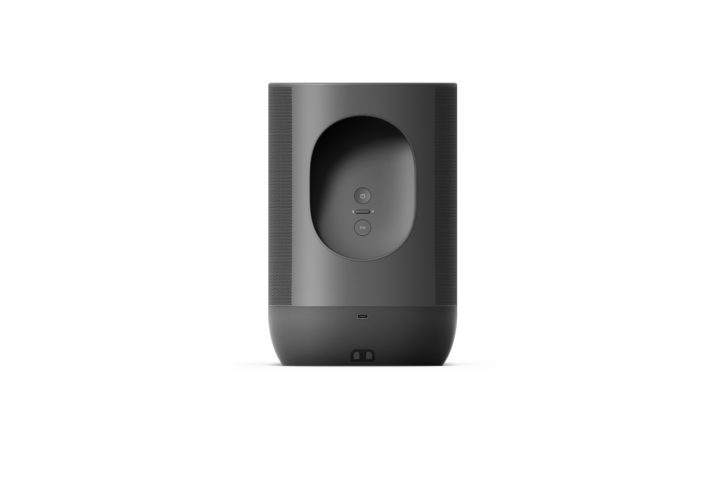
Setting up the Move is a simple process done via the Sonos app (iOS or Android). Move requires a wireless connection (802.11 b/g/n, 2.4 and 5 GHz), so you’ll need either a strong Wi-Fi signal or add a Sonos Boost to create a wireless Sonos network. Within the app you can add Amazon Alexa and/or Google Assistant voice control, turn automatic Trueplay tuning off, adjust basic bass/treble/loudness EQ settings, set a maximum volume limit, and more.
In fact, much more.
As mentioned earlier, the Sonos software/app is one of the big reasons why the company leads the wireless speaker race. With it you can set alarms, sleep timers, have access to virtually any streaming service on the planet (though still no support for high-resolution audio files), rename speakers, turn status lights and touch controls off, adjust compression rates, search music across multiple services, group multiple speakers/rooms together in any combination, etc. While two Moves can be paired to form a stereo field, you can’t pair a Sonos subwoofer with them, and you can’t use the Moves as surround speakers with a Playbar or Beam. Also, you can only Bluetooth to a single speaker, not to a stereo pair.
The app also displays the current battery percentage remaining, even when operating in Bluetooth mode, meaning you’ll always know how much longer you can party.
As great as the Sonos app and feature set is, it’s all for naught if the Move underwhelms sonically, but fortunately it punches way above its weightclass when it comes to performance. While it can’t plumb the deepest bass notes, it produces a surprising amount of rich low end, such as jazzy double-bass string plucks or synth-pop electronic drum hits. The tweeter also resolves delicate cymbal brush strokes and delivers vocals with clarity. It also plays impressively loud, delivering peaks of over 90 dB at 10 feet away; maybe not loud enough to power a full-on pool party, but certainly enough to fill any room with sound.
You can’t expect a lot of sonic width from any single speaker system — though Riva’s Trillium technology does an admirable job — and that is really where one Move shows its limitations. With just one Move, sound was always localizable and focused around the speaker. However, when you pair two Moves together in stereo…Wow! A stereo pair of Moves was incredibly impressive, improving the sound quality across the board. Music now had depth and imaging and a real soundstage. Bass performance is also improved. I brought the pair into my showroom and people were shocked that all of that sound was coming from just two small speakers.
With a stereo pair of Moves, the customer gets way better sound in a primary listening location, plus has the ability to easily separate the stereo pairing in the Sonos app and carry the speakers into other rooms for temporary listening. This seems like the ultimate Move sales strategy. If the Move has only one potential negative, it is that it is so good, it will possibly cannibalize other Sonos sales, with people buying one or two Moves to carry around the house.
Bottom line, the Move is a total homerun for Sonos, ticking every box it needs to — design, battery life, durability, performance — and delivering everything a customer could ask for. I think it represents the biggest and most exciting product launch in Sonos’ history. Bring these into your showroom and you will sell them.
800-680-2345; Sonos.com
Kudos: Beautiful industrial design with integrated carrying handle and nearly foolproof charging base; full-range sound; long battery life; it’s a Sonos
Concerns: No high-resolution playback; may gobble some of your other Sonos sales
Product Specs:
- Portable speaker with integrated carry handle and 36-watt-hour battery rated at 10 hours of use
- Two Class-D amplifiers independently drive integrated downward-firing tweeter and mid-woofer
- IP 56 rated for protection from dust and splashes; designed to withstand drops up to 6 feet
- Far-field microphone used for Google Assistant or Amazon Alexa integration and for Trueplay room correction
- Wi-Fi connection to network (802.11 b/g/n, 2.4- and 5 GHz)
- Bluetooth and Apple AirPlay2
- Capacitive touch controls for volume up/down, previous/next track, play/pause, microphone on/off
- Dimensions: 9.44 x 6.29 x 4.96-inches (HxWxD); 6.61 pounds

